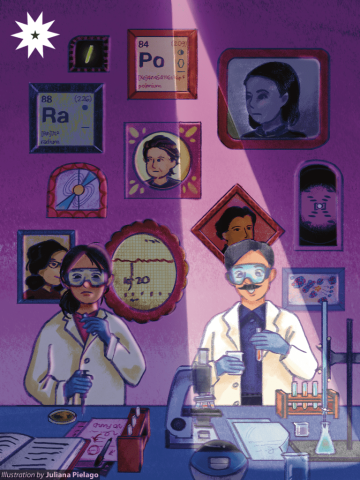In a world rife with sexism and misogyny, can science be spared?
Science has historically been perceived as the torchbearer of knowledge. Even now, it is often seen as the superior academic currency—one that trades facts and universal truths instead of human foibles and conjecture. Yet when it comes to women, so much of the story is wrong.

The record of terrible research and bias against women dates back centuries. Charles Darwin, for instance, argued that women were less evolved than men. “The chief distinction in the intellectual powers of the two sexes is shown by man attaining to a higher eminence, in whatever he takes up, than woman can attain,” he wrote in his book The Descent of Man. “Thus, man has ultimately become superior to woman.”
Like many of his contemporaries, Darwin conveniently ignored how women were denied access to higher education and had no right to own property. Instead of acknowledging these systemic barriers, many scientists continued to use their authority to perpetuate the myth of an inferior sex. Some once claimed that women were less intelligent than men because they had smaller skulls. By the same logic, an elephant’s intelligence dwarfs humanity’s as a whole.
Although our society has moved past these outdated mindsets, the legacy of sexism in science remains. In 2013, the New York Times found over 30,000 scientific articles on sex differences since the turn of the millennium. Many of these studies attempted to compare the male and female brain. They suggested that men were wired to understand machines while women were wired to be more empathetic. The unavoidable implication here is that people are built for different roles—women are biologically suited to be homemakers, while men are better off as innovators and builders.
According to Neuroscientist Gina Rippon, this is a fundamental misunderstanding of how the brain works: “[The brain] is actually very flexible and plastic throughout our lives.” Rather than solely focusing on biological factors, she believes that scientists should look into how culture, relationships, and social norms influence people’s behavior and abilities.
However, this does not mean that differences between the sexes should be completely ignored. “Many diseases differ between sexes,” Rippon says, such as Alzheimer’s disease and depression.
This can be dangerous territory, especially since sex differences have been used to discredit women. Many female activists and scientists have opposed the notion that science should determine how we live and our basic rights—and they are right. But whether or not it sits easily with us, we cannot ignore science either. If biological differences exist and we want to build a fairer society, then we need to be able to understand these gaps and accommodate them.
For example, there is currently no cure for premenstrual syndrome (PMS) even though 90 percent of women experience it. Meanwhile, there are five times more studies on erectile dysfunction than on PMS, even though only 19 percent of men experience it. This is because some grant reviewers, who are usually men, simply do not believe that PMS exists. This further proves how easy it is for science to slide into the realm of subjectivity. Even when the observations are skewed, they can hide behind the mantle of scientific objectivity and escape further scrutiny.
It does not help matters that women have been consistently excluded from the scientific community. Marie Curie was rejected from the French Académie des Sciences in 1911—the same year she won her second Nobel Prize. In 1974, Jocelyn Bell Burnell discovered the first radio pulsars, yet the recognition went to her male supervisor. Rosalind Franklin was instrumental in determining the structure of the DNA, but like Burnell, her contribution was overshadowed by her male peers.
Throughout history, we have to hunt for women in science—not because they were incapable of doing research, but because for such a large chunk of time, they did not have the chance. To this day, there is still an appalling shortage of women in the science, technology, engineering, and mathematics sectors, which can create a space for prejudice to creep in.
To address these issues, we need to incorporate multiple perspectives in the conduct of scientific research. By recognizing alternative ways of perceiving science, we can avoid producing inaccurate studies and marginalizing certain sectors of society. We also cannot ignore the probability of any form of bias coloring these works. After all, scientists are still human beings. They can still get things wrong. In fact, a significant part of the scientific process is making mistakes and correcting them.
If we place science at par with other fields like art and religion, it is possible to question the claims of the discipline itself—who produces the information, why is certain information being made, and how will that information be used. Questioning the fundamental assumptions made in and by the scientific discourse is crucial for anybody who is engaging with it.
